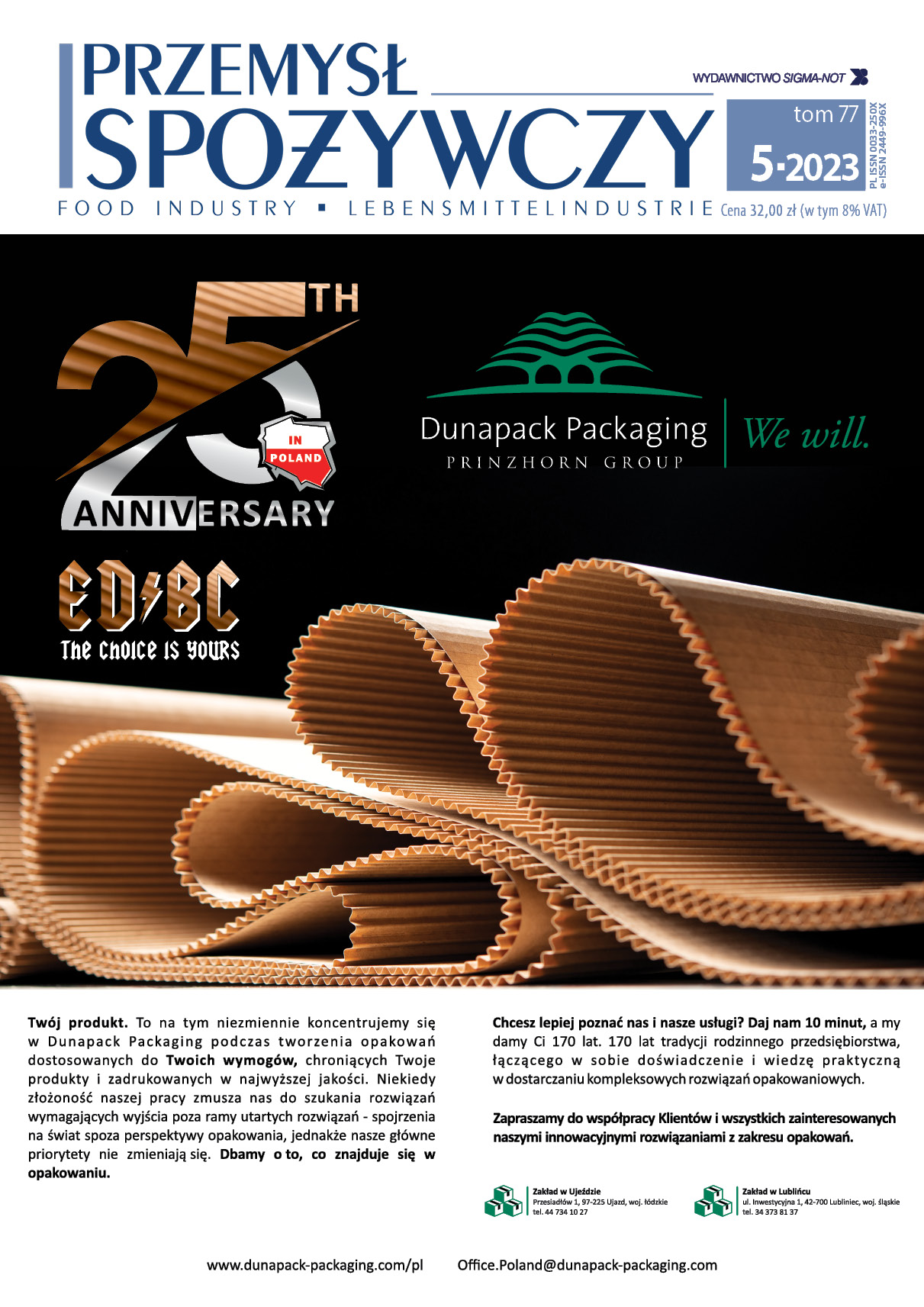ECONOMY
- Investments In the Food Industry (DOI10.15199/65.2023.5.1)
Jadwiga Drożdż 2
In the food industry, after many years of investment recovery, starting with the outbreak of the COVID-19 pandemic, there is a reduction in investment outlays in real terms. The purpose of this article is to assess the investment activity of food industry enterprises, both of the sector as a whole and of its main divisions and industries, in the years 2010-2022, i.e. also under conditions of a sharp increase in the price of energy raw materials and capital expenditures. The analysis shows that the investment rate in the food industry has decreased, the structure of investment outlays has deteriorated, and the sector of small and medium-sized food companies is in the most difficult situation. The weakening of investment activity in the food processing industry from 2020 was the result of producers refraining from making investment decisions due to uncertainty related to the valuation of investment costs, and from 2022 also as a result of the war in Ukraine, which radically changed the economic and geopolitical situation. Despite various difficulties related to ensuring the continuity of supply chains and rising production costs, food producers see the need to invest in modern technologies, rational ways of energy consumption, sustainable production, all of which is conducive to the search for new development paths.
KEY WORDS: ood industry, investment outlays, investment rate
- Innovation Activities of Food Industry Enterprises in The Years 2019-2021 (DOI10.15199/65.2023.5.2)
Iwona Szczepaniak 9
The article presents changes in defining and measuring innovation and innovativeness in accordance with the existing methodology included in the Oslo Manual. The level of innovation of the food industry in Poland against the background of the total manufacturing sector in 2019-2021 was presented. Both the results and expenditures of innovative activity were characterized. It was assumed that the expenditures determine the ability of companies to create innovations, and the results allow to assess the effects of innovative activity. In addition, reference was made to the issue of cooperation between companies in innovation activities, referring to the open innovation model. The analysis showed that the involvement of food industry enterprises in innovative activities is not too high, which may pose a significant threat to the further development of the sector. In this context, it was emphasized that innovation is an important factor in economic development of food industry enterprises in Poland and a determinant of its international competitiveness.
KEY WORDS: innovation, innovativeness, food industry, development, competitiveness
LAW
- Durability – An Integral Part of Food Quality (DOI10.15199/65.2023.5.3)
Anna Niepsuj-Wójkowska 14
Consumer expectations towards food quality are constantly growing. The key is not only the high quality of the food at the time of its introduction to the market, but also its stability throughout the shelf life declared by the manufacturer. The obligation to label food with the date of minimum durability or expiry date results from Article 24 of Regulation (EU) No 1169/2011 of the European Parliament and of the Council of 25 October 2011.
Currently, in pursuit of the objectives of the „From Farm to Fork” Strategy, the European Commission is working on amending Regulation No. 1169/2011. Foods marked with the date of minimum durability may be safely consumed by consumers after the indicated date. Therefore, as part of the fight against food waste, the above-mentioned legislative work has been undertaken, the aim of which is (above all) to change the wording preceding the date of minimum durability, so that it is more understandable for consumers.
KEY WORDS: food safety, shelf life of food, date of minimum durability, ‘use by’ date
TECHNICS-TECHNOLOGY
- Plant Proteins and Polysaccharides in Microencapsulation of Essential Oils for Development of Functional Food Sector (DOI10.15199/65.2023.5.4)
Alicja Napiórkowska, Marcin Andrzej Kurek 20
The escalating interest in functional foods among consumers, coupled with their heightened nutritional consciousness, is driving the need for innovative strategies for product development in the food industry. Essential oils, possessing health-promoting benefits, antimicrobial and antioxidant activities, present a promising avenue for the functional food industry. However, their high volatility, susceptibility to oxidation, and strong flavor and aroma impede their large-scale use. Microencapsulation, particularly spray drying, is a well-established technique to circumvent these issues. Nevertheless, the high risk of essential oil evaporation during the process at elevated temperatures requires alternative encapsulation method. One promising solution is the application of complex coacervation between plant proteins and polysaccharides, which not only enables encapsulation at room temperature but also guarantees efficient retention of essential oils and protection from environmental degradation during storage. This review introduces the definition of functional food and addresses the possibility of using protein-polysaccharide complexes for essential oil encapsulation and highlights the potential of complex coacervation as a new strategy for the development of this food sector.
KEY WORDS: plant proteins, polysaccharides, essential oils, complex coacervation, functional food
- New Technologies Used in The Snacks Industry (DOI10.15199/65.2023.5.5)
Kamil Wawrzyniak, Grzegorz Ligaj, Bartłomiej Wióra, Sandra Zielińska, Sylwia Baluta 24
Snacks are now an integral part of the diet of an ever-growing population and have accompanied people for a long time, satisfying the need to eat something quick and filling between meals. While traditional snack foods such as potato chips, are still ubiquitous and popular around the world, healthier alternatives are increasingly being sought. In addition, the technological processes that allow the production of snacks are also changing, becoming more ecological and more often allowing for the maximum preservation of nutrients. This overview presents the technological trends in the development of snacks.
KEY WORDS: chips, meat snacks, fruit snacks, vegetable snacks
FOOD-FEEDING
- Traditional And New Directions of Using Probiotics (DOI10.15199/65.2023.5.6)
Kinga Malczewska, Julia Kopczyńska, Olha Kostiuchenko, Joanna Żylińska-Urban, Magdalena Kowalczyk 28
The rapid development of research on probiotics in recent years has resulted from the increasing knowledge about the importance of the human gut microbiota and the consequences of imbalances of intestinal microorganisms – so-called gut dysbiosis. The multitude of studies have revealed the beneficial effects of probiotics, which include modulation of the gut microbiota, the host’s systemic metabolic response, immune system, intestinal barrier, nervous system and cancer development. In order to restore intestinal homeostasis, comparative microbiome analyses identify new strains, including commensal strains isolated from the gastrointestinal tract, to be used as traditional or next-generation probiotics. The selection of new, often oxygen-sensitive probiotic microorganisms, and the development of therapeutic probiotics contribute to the optimization of probiotic production.
KEY WORDS: traditional probiotics, next-generation probiotics, health, probiotic mechanisms of action
- Sensory Quality of Plant-Based Protein Snacks (DOI10.15199/65.2023.5.7)
Inga Klimczak, Daniel Głogowski, Radosław Bezler 33
The aim of the study was to design snacks based on plant protein and evaluate their sensory quality. Based on organoleptic tests, the expert team selected textured pea protein as the base for the designed snacks. The main criterion for selecting the plant protein was to ensure the products’ texture. The conducted research showed that the snacks differed significantly in terms of color, intensity of salty taste and intensity of spicy notes. The use of „just about right” hedonic scale made it possible to determine the optimal intensity of the selected quality characteristics of the snacks. The obtained sensory profiles can be useful for manufacturers when creating snacks to ensure their high organoleptic quality and consumer acceptance.
KEY WORDS: snacks, plant protein, design, sensory quality, consumer acceptance




